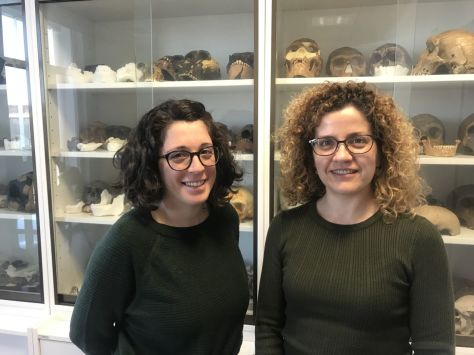NewsNext Previous
The spread of steppe and Iranian-related ancestry in the islands of the Western Mediterranean
IPHES researchers Beatriz Gamarra and Marina Lozano, from the Paleoanthropology department, have collaborated in this research
The Mediterranean Sea has been a major route for maritime migrations as well as frequent trade during prehistory, yet the genetic history of the Mediterranean islands is not well documented despite recent developments in the study of ancient DNA.
An international team led by Researchers from the University of Vienna, Harvard University and University of Florence, Italy, is filling in the gaps with the largest study to date of the genetic history of ancient populations of Sicily, Sardinia and the Balearic Islands, increasing the number of individuals with reported data from 5 to 66.
The results reveal a complex pattern of immigration from Africa, Asia and Europe which varied in direction and timing for each of these islands. IPHES researchers Beatriz Gamarra and Marina Lozano, from the Paleoanthropology unit, have collaborated in this research. Beatriz Gamarra, now postdoctoral fellow Beatriu de Pinós at IPHES, during her previous period at University College of Dublin (UCD, Ireland), prepared some of the bone samples that were later analyzed by the leading authors of this research in the ancient DNA laboratories of UCD, University of Vienna and Harvard University. Marina Lozano, IPHES researcher and Associate Professor at URV, analyzed the human remains of Cave 127 (Formentera) providing the samples of these individuals and the anthropological context of this site.

Some of the paper’s most striking findings concern the island of Sardinia. Despite contacts and trade with other Mediterranean populations, ancient Sardinians retained a mostly local Neolithic ancestry profile until the end of the Bronze Age.
However, during the second half of the 3rd millennium BC, one of the studied individuals was of entirely of North African ancestry. Together with two Iberians reported in 2019, this new more than 1% of studied individuals from southern Europe from the Copper and Bronze Ages were part of immigrant families from North Africa.
“Our results show that maritime migrations from North Africa were widespread and important long before the era of the eastern Mediterranean seafaring civilizations and moreover were occurring in multiple parts of the Mediterranean”, says Ron Pinhasi, a co-senior author of the department of Evolutionary Anthropology, University of Vienna.
During the Iron Age expansion and establishment of Greek and Phoenician colonies, the Sardinian individuals analyzed from that period had little, if any, ancestry from the previous long-established populations.
“Despite these population fluxes, modern Sardinians retained 56-62% of ancestry from the first Neolithic farmers that arrived in Europe around 8000 years ago”, says David Caramelli a co-senior author, and Director of Department of Biology at the University of Florence.
The team’s results on Sardinia are fully consistent with the findings of another paper on ancient Sardinian genetics published on the same day in the journal Nature Communication and led by John Novembre, Johannes Krause and colleagues.
The paper also goes beyond Sardinia to understand population changes in other central and western Mediterranean islands.
“One of the most striking findings concerns the arrival of ancestry that ultimately came from the Russian Steppe. While the ultimate origin of this ancestry was Eastern Europe, in the Mediterranean islands much of it arrived from the west, and in fact we can pinpoint Iberia as its specific source”, says David Reich, a co-senior author at Harvard University, who is also an Investigator of the Howard Hughes Medical Institute and at the Broad Institute of MIT and Harvard. “This was likely also the case for the Balearic Islands, in which some early residents probably derived at least part of their ancestry from Iberia”, says first author Daniel Fernandes, of the department of Evolutionary Anthropology, University of Vienna.
Sicily was also impacted from the east by a different movement. People with ancestry related to ancient Greek “Mycenaeans” reached Sicily at a time overlapping the period of Mycenaean trade connections to the island. An important direction for future ancient DNA work will be to determine whether it was Greek migrants, or people from further east in the Mediterranean, who carried this ancestry to Sicily.
Reference
Fernandes, D.M., and alter 2020. “The spread of steppe and Iranian-related ancestry in the islands of the western Mediterranean”. Nature Ecology and Evolution.


